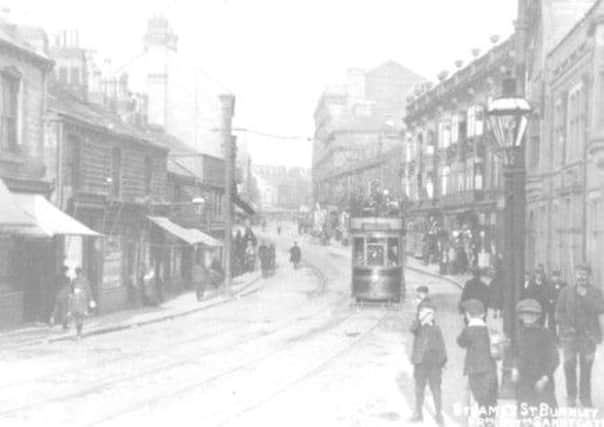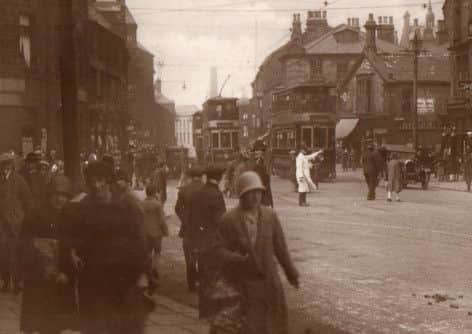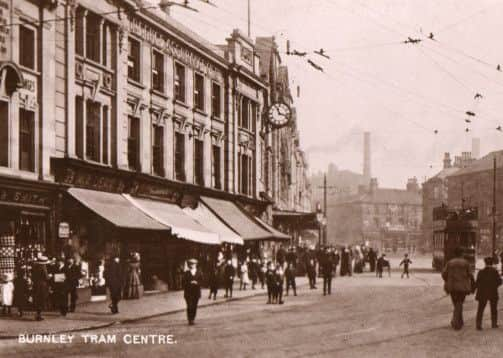Booming shops of Burnley’s past


That, for us in north east Lancashire, is an inaccurate view in that most of our women and girls found employment in the textile industry whether in the home or, later on, in the mill. Other parts of the country saw employment for women in local industries of their areas. Women were employed in the fishing industry, not out on the boats, but in the processing industries, in places like Whitby and Grimsby and a host of other fishing ports all along the coast.
It might have been thought mining was a man’s industry but, even there, women and children had a role. Women were often found working in the early mining industry sorting and washing the coal at the pit head. Of course, women were in service often many miles from their homes. I remember reading, in Roger Mason’s “Grannies Village”, which is about Thornton-in-Craven, where my family had distant relations, about a young girl who, old enough for work, had been found a place at the “big house” less than a mile down the road. Not surprisingly she was reluctant to enter the world of work even though she would have been working almost within shouting distance of her mother. Incidentally, “Grannies Village” is something of a masterpiece of its kind and is well worth reading.
Advertisement
Hide AdAdvertisement
Hide AdIt is not about women and their work in retailing that interests me at the present time. I have been looking at retailing in Burnley for a book I have been writing and have come to the conclusion that, in employment terms, shops were once vital to the local economy. The book will not be about the history of shopping in Burnley. It will be more general than that, but retailing will play a part.


I have written a history of shopping in Briercliffe which is due out soon. It is called, “A Ha’porth o’ Liver: The History of Shops and Shopping in Briercliffe” and it will be published by the Briercliffe Society.
Last week, I gave a presentation on the subject to the Wednesday Club in Briercliffe Community Centre. It was little more than a series of old postcard images showing the shops of Harle Syke, Haggate and Lane Bottom, together with a few anecdotes, but it seemed to go down well.
You might like to know how it was that I arrived at the title which, you will agree, is an odd one. I got the idea when reading Hazel Wheeler’s “Half a Pound of Tuppenny Rice: Life in a Yorkshire Village Shop”. What a good title, I thought, remembering the famous rhyme. It got me thinking about a title for something I had had in mind for a long time.
Advertisement
Hide AdAdvertisement
Hide AdThen, I was told the story of the Harle Syke tackler who was sent, by his domineering wife, to the local butchers for a “ha’porth of liver”. He did as he was bid but, almost before he got home, everyone in the village knew what had asked for in the shop and the man became known as “Ha’porth o’ Liver” for the rest of his life.


Could this be true, I questioned? Apparently, it was. I mentioned the story to a number of elderly men and women in the village and they could tell me not only the name of the tackler, where he lived and worked, the name of his wife and that of the butcher who had made, if not his most profitable sale, his most famous one! Also, I realised I had known the man and his wife but, though I must have heard, his byname (nickname, to you foreigners) it had not registered.
I ought to explain that lots of people, in the old days, in Briercliffe were known not by their real names but by their bynames. These often derived from their families, where they had worked or some characteristic. However, being known as “Ha’porth o’ Liver” was something of a classic. I could not let the opportunity slip and so the phrase is to appear in the title of the book though others have been suggested, “A Penn’orth o’ Tripe” being one of them!
Even though I say it myself, “A Ha’porth o’ Liver” is a good title because the words were uttered in a shop and a commercial transaction was involved. It might be argued the use of the phrase sums up the essential law of supply and demand, the law upon which all transactions in shops, and their successors the supermarkets, is based.
Advertisement
Hide AdAdvertisement
Hide AdAt some time in the inter-war years of the 20th Century a man was sent by his wife to the local butchers and was told to ask for a “ha’porth o’ liver”. She probably pushed a halfpenny into his hand as she sent him out of the house on his quest. The task given to the young man might not have matched the one given to Jason, and the story might not be as famous, but people alive today remember the event and still talk about it. They talked about it at the Wednesday Club only last week.
This is not getting me to the point I want to make in this article and that is about the economic importance of the retail industry in Burnley in the past. I have, in my possession, a copy of Barrett’s Commercial Directory for our town for 1927. In it you will find the names and addresses of 54 bakers, 120 butchers, 34 chemists and druggists, 475 confectioners, 35 cooked meat stores, 57 fish dealers, 136 fried fish dealers, 136 fruiterers and greengrocers, 421 grocers, 14 herbalists, 7 ice cream dealers, 18 tea and coffee dealers, 25 tripe dressers and 14 wine and spirit merchants.
The 1927 Directory does not mention a single supermarket and, perhaps only few national chains. Examples of the latter include, among the butchers, for example, the Argenta Meat Co. Ltd, which had six branches in Burnley, and the British and Argentine Meat Co. Ltd, which had seven shops in town.
When considering the immense list of grocers (421) only one was from a famous national chain, Lipton’s Ltd, who had a shop at 15 Market Street. So far as I can tell, all the others were local shops depending on local wholesalers for their supplies. There were grocers’ shops on a high proportion of local streets in all districts of the town, 10 in Briercliffe alone, and these did not include those listed in the category of “shop-keepers”, many of which were essentially grocers, another 141 shops!
Advertisement
Hide AdAdvertisement
Hide AdSome of these firms like Metcalf Bros, who described themselves as “high class grocers, tea blenders and coffee roasters”, in addition to their Burnley premises, at 52 St James’s Street and in Bridge Street, had shops at Nelson, Padiham, Todmorden, St Anne’s and Oldham. The Burnley firm of Abraham Altham Ltd remained tea merchants, though previously they had been the largest chain of grocers in England. In those days they had run branches throughout Lancashire, the West Riding and into Lincolnshire. In 1927 their main shop was in Market Street, Burnley, but they had branches in Burnley, Nelson, Colne and Padiham.
The Burnley Equitable Co-operative and Industrial Society was the town’s biggest shopkeeper being grocers, drapers, boot makers, cloggers, bakers, butchers and a whole lot more. They had branches in all parts of town, six in Briercliffe alone, and 44 are listed in the Directory. Note that when I counted last, Booth’s, the supermarket, only had 29 branches! It makes you think about just how big the Co-op was and how foolish the managers of this organisation have been over the intervening 80 or so years.
There are a few interesting facts that can be drawn from the list I have given you. Have you noted the number of confectioners? There were 475, with some 54 bakers in addition. These are remarkable figures even if a few of the firms appear in both lists. Confectionery ranged from the baking of bread and oat cakes, through to the making of pies, cakes and biscuits but it also included the making of toffee and chocolate and both of these categories are represented in Burnley. It is also worth pointing out the list of confectioners included shops that merely sold but did not make toffee or chocolate. Other confectioners did not make their own bread or cakes but bought them in from specialist bakers like Spencer’s of Nelson, who were noted for the quality of their bread.
I was surprised by the number of fish dealers and it is clear one or two of them had their own trawlers at Fleetwood. Another surprise was the 136 fried fish dealers. I knew fish and chips was a most important and cheap source of nourishment for many poor families. It is clear that, in Burnley, the most popular takeaway of the past was fish and chips though we must not forget the pie and pea shops like the famous Yankee Bar in Burnley town centre, though there were others particularly in Briercliffe where there were at least three equivalents, two of them known as Yankee Bars.
Advertisement
Hide AdAdvertisement
Hide AdThis brings me to another point. The figures I have given you relate only to Burnley and Briercliffe. This is because that is how the details were presented in the 1927 Commercial Directory. Padiham, Hapton, Worsthorne and Cliviger are excluded from the statistics though it appears Clowbridge, Dunnockshaw and Habergham Eaves were included.
So what are the final points that can be made from the material we have here? The first relates to the number of jobs provided by the retail trades. I have mentioned over 1,000 businesses, many of which would have been very small, but others would have employed quite a few individuals.
The firms I have mentioned come only from part of the retail sector. I have not mentioned Burnley’s three Department Stores, nor have I mentioned the drapers, ladies and gentlemen’s outfitters, tobacconists, hardware shops, “beersellers, off the premises”, as the Directory calls them, and a number of other categories.
The retail trade in Burnley was huge. It was mostly in the hands of local families. It was the case that many local girls and young men were merely “shop girls” or “shop men” but others were members of the families which owned the businesses. What a contrast to today when so few of our present-day shop workers are merely employees. What changes we have seen. I need to say little more to add to my contention that the retail trades were vitally important for employment in Burnley.